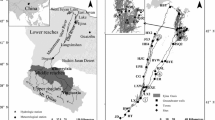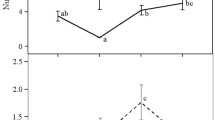Abstract
Euphrates poplar (Populus euphratica) is a key species of Tugai forests in the central Asian deserts and has been the topic of dendrochronological studies in west China since the 1980s. However, little is known about its growth performance at its highest occurrence in the southern Qaidam Basin of the northern Tibetan Plateau. Increment cores of the Euphrates poplar population there did well cross-date and thus showed a high dendrochronological potential. Its growth was persistently positively correlated with temperature from previous September to current August although not significant throughout. The annual precipitation of around 41 mm can not exert any significant effect on Euphrates poplar growth in view of the extremely high annual pan evaporation of 2,150 mm. Water in the nearby Tuolahai River is limited to the period from June–September. The positive correlation of tree growth with spring/early summer temperature indicates that the riparian Euphrates poplar trees may benefit from an increasing river runoff due to an advanced and accelerated snow and glacier melting under warmer conditions. An above-average autumn/early winter temperature in the preceding year may lead to an extended water flow in the river bed and hence to an increased tree growth in the next year. It is crucial to protect this invaluable natural forest from undue human activity.






Similar content being viewed by others
References
Biondi F, Waikul K (2004) DendroClim 2002: a C++ program for statistical calibration of climate signals in tree-ring chronologies. Comp Geosci 30:303–311
Bräuning A (1994) Dendrochronology for the last 1400 years in eastern Tibet. Geo J 34:75–95
Briffa KR, Jones PD (1990) Basic chronology statistics and assessment. In: Cook ER, Kairiukstis LA (eds) Methods of dendrochronology: applications in the environmental sciences. Kluwer, Dordrecht, pp 137–152
Cherubini P, Gartner BL, Tognetti R, Bräker OU, Schoch W, Innes JL (2003) Identification, measurement and interpretation of tree rings in woody species from mediterranean climates. Biol Rev 78:119–148
Cook ER, Kairiukstis LA (eds) (1990) Methods of dendrochronology: applications in the environmental sciences. Kluwer, Dordrecht
Gou XH, Chen F, Cook E, Jacoby G, Yang M, Li J (2007) Stream flow variations of the Yellow River over the past 593 years in western China reconstructed from tree rings. Water Resources Res 43:W06434. doi:10.1029/2006WR005705
Holmes RL (1983) Computer-assisted quality control in tree-ring dating and measurement. Tree-Ring Bull 43:69–78
Kong G, Luo T, Liu X, Zhang L, Liang E (2012) Annual ring widths are good predictors of changes in net primary productivity of alpine Rhododendron shrubs in the Sergyemla Mountains, southeast Tibet. Plant Ecol 213:1843–1855
Körner C (2003) Alpine plant life: functional plant ecology of high mountain ecosystems. Springer, Berlin
Lan YC, Wang J, Kang ES, Ma QJ, Zhang JS, Chen RS (2002) Snow cover monitoring by remote sensing and snowmelt runoff calculation in the upper Huanghe River basin. Chin Geogr Sci 12:120–125 (in Chinese with English summary)
Liang E, Eckstein D (2009) Dendrochronological potential of the alpine shrub Rhododendron nivale on the south-eastern Tibetan Plateau. Ann Bot 104:665–670
Liang E, Liu X, Yuan Y, Qin N, Fang X, Huang L, Zhu H, Wang L, Shao XM (2006) The 1920s drought recorded by tree rings and historical documents in the semi-arid areas of northern China. Clim Change 79:403–432
Liang E, Lu X, Ren P, Li X, Zhu L, Eckstein D (2012) Annual increments of juniper dwarf shrubs above the tree line on the central Tibetan Plateau: a useful climatic proxy. Ann Bot 109:721–728
Liu Y, An ZS, Ma HZ, Cai QF, Liu ZY, Kutzbach JK, Shi JF, Song HM, Sun JY, Yi L, Li Q, Yang YK, Wang L (2006) Precipitation variation in the northeastern Tibetan Plateau recorded by the tree rings since 850 AD and its relevance to the Northern Hemisphere temperature. Sci China Ser D Earth Sci 49:408–420
Liu PX, Peng JF, Chen FH (2007) Hydrological response of Populus euphratica Olve. radial growth in Ejinaa Banner, Inner Mongolia. J Integr Plant Biol 49:150–156
Oberhuber W (2004) Influence of climate on radial growth of Pinus cembra within the alpine timberline ecotone. Tree Physiol 24:291–301
Qin C, Yang B, Bräuning A, Sonechkin DM, Huang K (2011) Regional extreme climate events on the northeastern Tibetan Plateau since AD 1450 inferred from tree rings. Glob Planet Change 75:143–154
Shang HM, Wei WS, Yuan YJ, Yu SL, Yu RD, Gao X (2008) Tree-ring width chronology of Populus euphratica from Aibi Lake area and its environmental significance. J Desert Res 28:815–820 (in Chinese with English summary)
Shao XM, Huang L, Liu HB, Liang EY, Fang XQ, Wang LL (2005) Reconstruction of precipitation variation from tree rings in recent 1000 years in Delingha, Qinghai. Sci China Ser D 48:939–949
Sun JY, Liu Y, Cai QF, Park WK, Li BS, Shi JF, Yi L, Song HM, Li Q (2006) Climatic and hydrological changes of Ejin, Inner Mongolia, China during the past 233 years recorded in the tree rings of Populus euphratica. Quat Sci 26:799–806 (in Chinese with English summary)
Wang S, Chen B, Li H (1996) Euphrates poplar forest. China Environ Sci Press, Beijing (in Chinese)
Wang J, Li H, Hao X (2010) Responses of snowmelt runoff to climatic change in an inland river basin, Northwestern China, over the past 50 years. Hydrol Earth Sys Sci 14:1979–1987
Westermann J, Zerbe S, Eckstein D (2008) Age structure and growth of degraded Populus euphratica floodplain forests in north-west China and perspectives for their recovery. J Integr Plant Biol 50:536–546
Xiao SC, Xiao HJ, Si JH, Xi HY (2010) Study on the sub-diurnal radial growth of the Populus euphratica. J Glacio Geocryol 4:816–822 (in Chinese with English Summary)
Yuan YJ (1989) Response functions for tree-ring chronologies of Populus euphratica in the middle stream of Tarim River. In: Li JF (ed) Research on dendroclimatology and dendrohydrology in Xinjiang. Meteorology Press, Beijing, pp 160–166 (in Chinese)
Zhang SB, Tian J, Yan CF, He WX (1996) Investigation on the characteristics of living conditions and ecology of Populus euphratica in the Qaidam Basin. Sci Technol Qinghai Agri Forestry 4:28–29 (in Chinese)
Zhang QB, Cheng GD, Yao TD, Kang XC, Huang JG (2003) A 2,326-year tree-ring record of climate variability on the northeastern Qinghai-Tibetan Plateau. Geophys Res Lett 30:1739. doi:1710.1029/2003GL017425
Zhang QB, Li ZS, Liu PX, Xiao SC (2012) On the vulnerability of oasis forest to changing environmental conditions: perspectives from tree rings. Landscape Ecol 27:343–353
Zhou HH, Chen YN, Li WH, Chen YP (2010) Photosynthesis of Populus euphratica in relation to groundwater depths and high temperature in arid environment, northwest China. Photosynthetica 48:257–268
Acknowledgments
This work was supported by the Special Scientific Research Project for Public Interest (GYHY201106013-2-2), the “Strategic Priority Research Program—Climate Change: Carbon Budget and Relevant Issues” of the Chinese Academy of Sciences (XDA05090311), and the National Nature Science Foundation of China (40890051).
Author information
Authors and Affiliations
Corresponding author
Additional information
Communicated by A. Braeuning.
Special topic: Dendroecology in Asia.
Rights and permissions
About this article
Cite this article
Liang, E., Ren, P., Zhang, S. et al. How can Populus euphratica cope with extremely dry growth conditions at 2,800 m a.s.l. on the northern Tibetan Plateau?. Trees 27, 447–453 (2013). https://doi.org/10.1007/s00468-012-0823-3
Received:
Revised:
Accepted:
Published:
Issue Date:
DOI: https://doi.org/10.1007/s00468-012-0823-3




